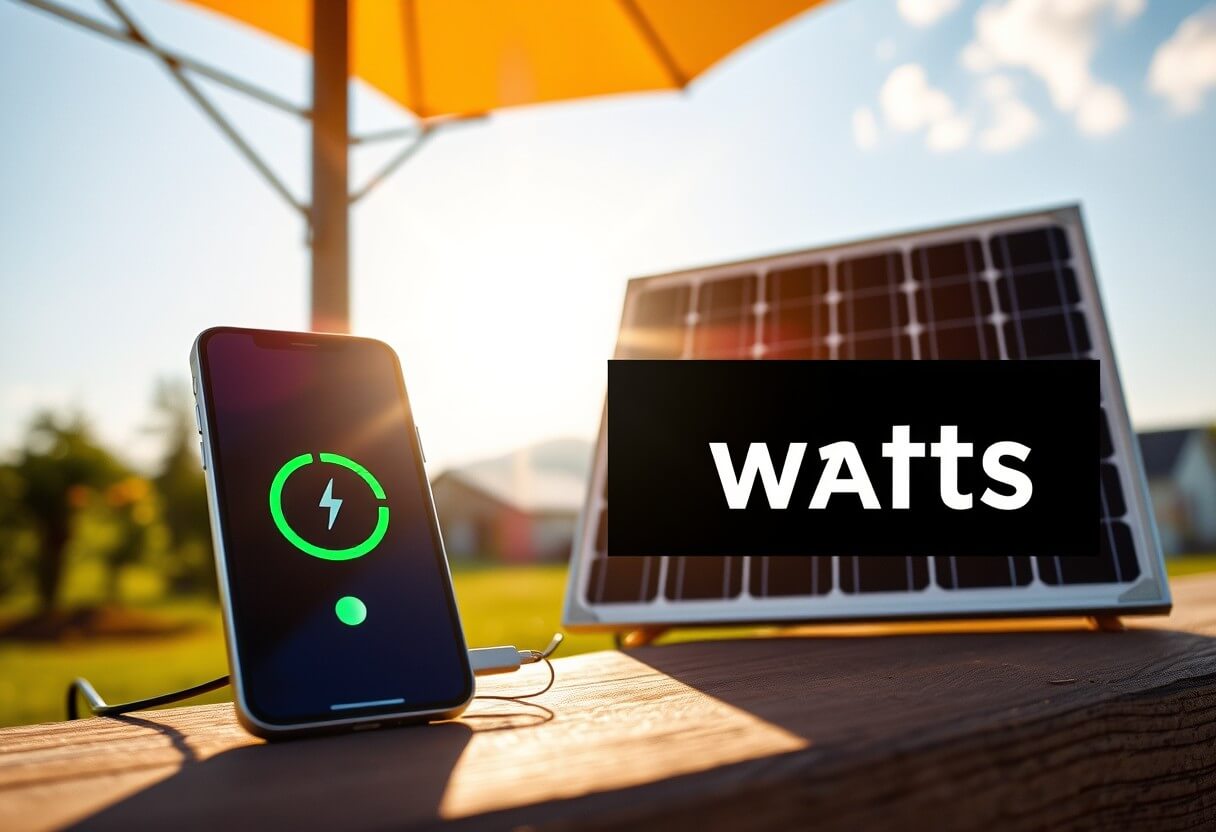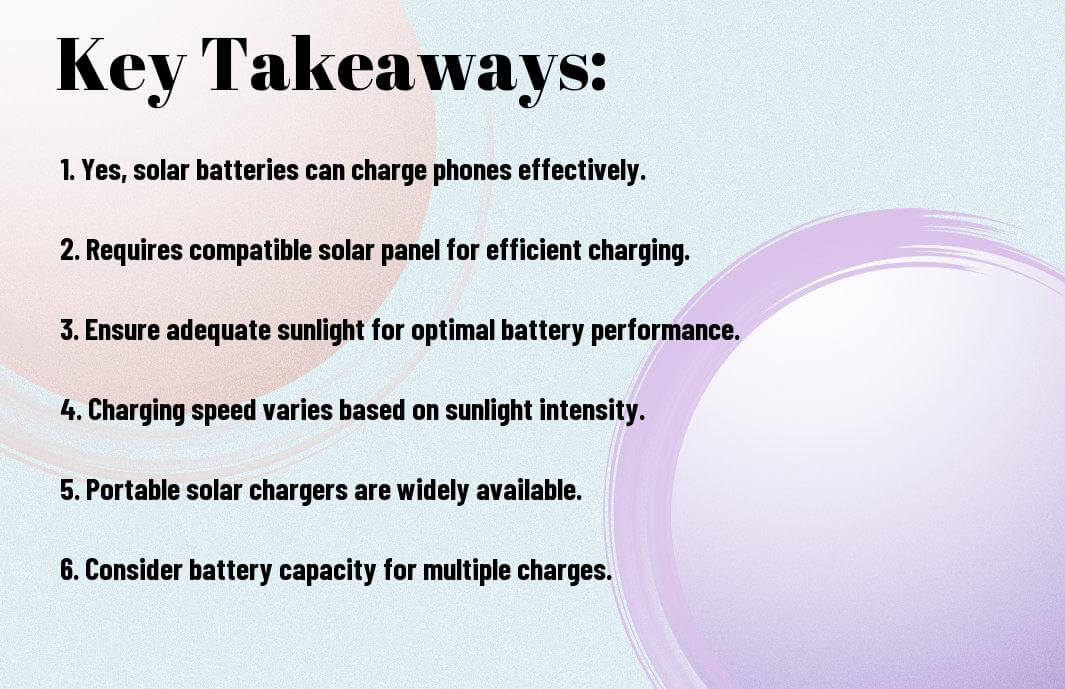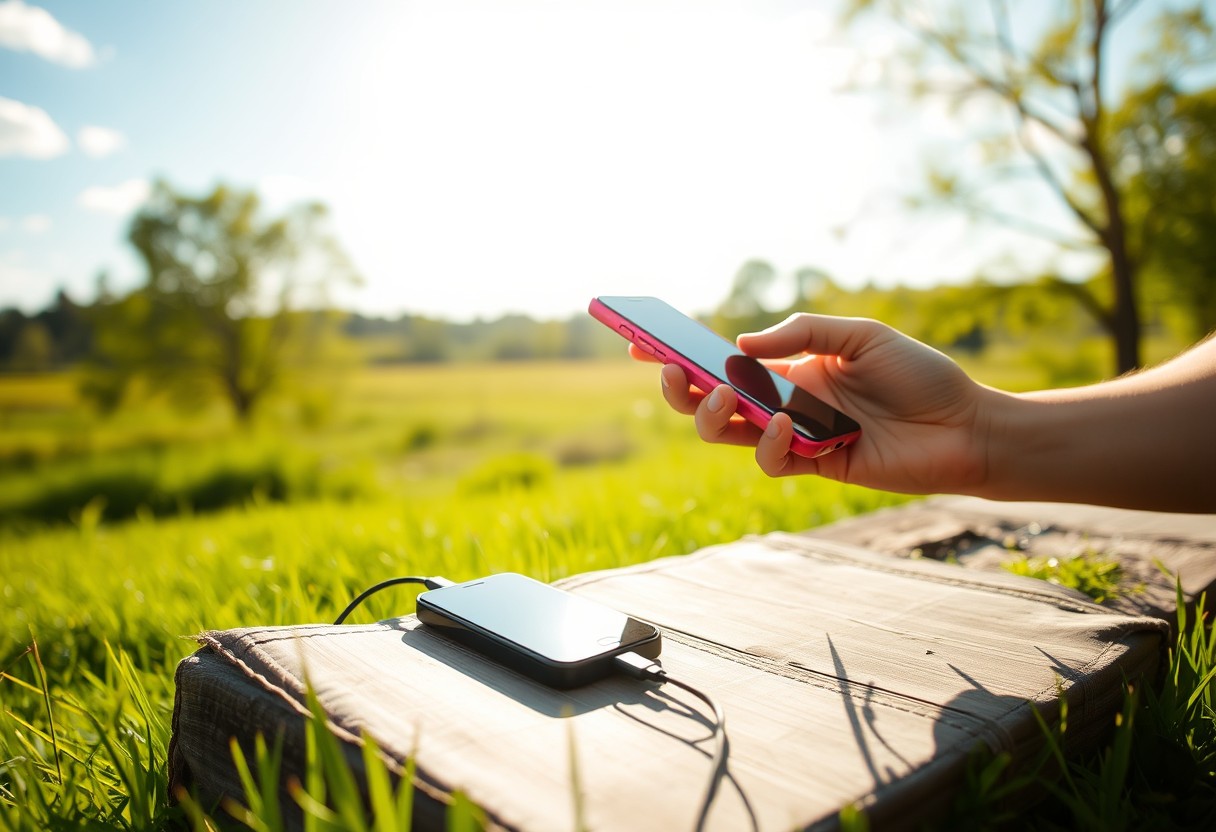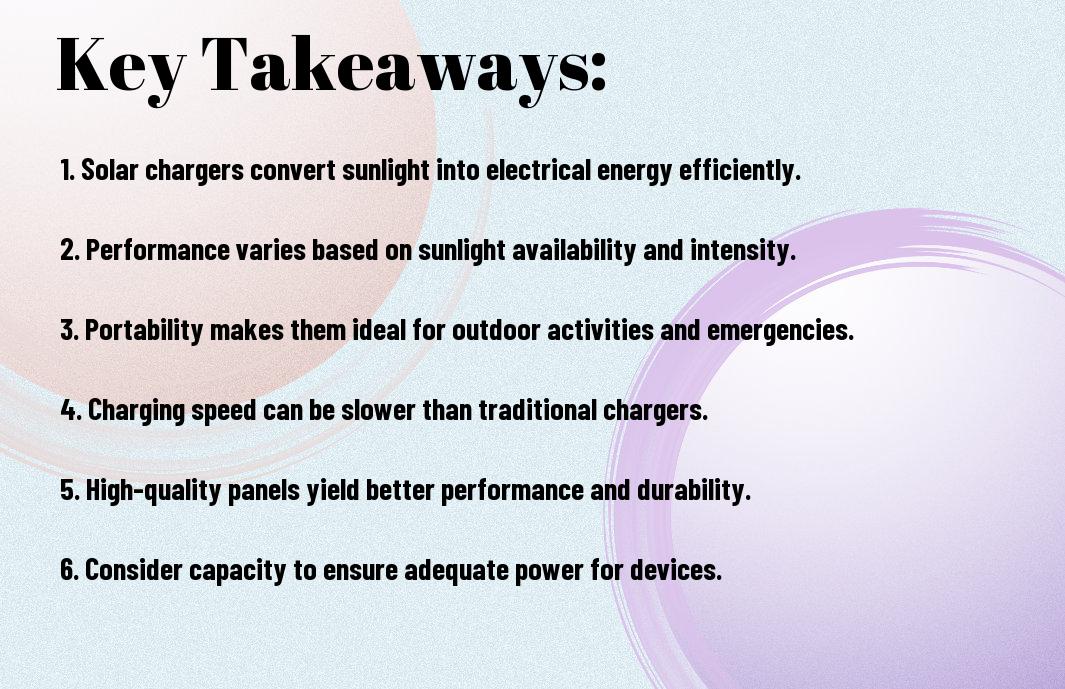Solar energy has emerged as a sustainable way to keep your devices powered, but determining how many watts of solar you need to charge your phone can be confusing. Understanding your phone’s battery capacity, charging requirements, and the efficiency of solar panels is crucial in making this calculation. In this guide, we will break down the factors you need to consider to ensure you have enough solar power to charge your phone effectively, allowing you to stay connected while being mindful of the environment.
Key Takeaways:
- Charging Needs: The average smartphone battery capacity is around 3000-4000 mAh, which typically requires about 10-20 watts to charge efficiently.
- Sunlight Availability: The amount of solar power you can generate depends on sunlight exposure, which varies based on location and weather conditions.
- Solar Panel Efficiency: Higher efficiency solar panels (around 20% or more) can produce sufficient energy to charge your phone within a few hours, even in low light.
- Battery Storage: Having a solar battery system can allow you to store excess energy for charging your phone when there is no direct sunlight.
- Portable Chargers: Consider investing in solar-powered portable chargers for convenience while on the go.
Understanding Solar Energy
While the concept of solar energy may seem complex at first, it is fundamentally based on harnessing sunlight to produce electricity. Solar energy is derived from the sun’s rays, a renewable and abundant resource that is accessible to everyone. By converting sunlight into usable energy, you can dramatically reduce your reliance on fossil fuels, lower your carbon footprint, and save on electricity costs.
What is Solar Energy?
An important aspect of solar energy is its renewal; unlike conventional energy sources that can be depleted and contribute to environmental degradation, solar power harnesses an inexhaustible resource. The process involves the capture of sunlight, which is then transformed into electricity either through photovoltaic (PV) systems or solar thermal systems. As you explore the options available for solar charging, understanding the basic principles behind solar energy will empower you to make informed decisions regarding your energy needs.
The Basics of Solar Panels
On your journey to implementing solar energy, it is crucial to familiarize yourself with solar panels. These devices consist of numerous solar cells that work together to capture and convert sunlight into electricity. The most common type of solar panels is photovoltaic panels, made from silicon and designed to produce electric current when exposed to sunlight. You will find that not only do solar panels reduce your energy bills, but they also significantly contribute to sustainability efforts by promoting a clean energy future.
It is imperative to note that solar panels come in different types and efficiencies, impacting the overall amount of energy generated. Factors such as panel orientation, shading, and local climate can affect their performance. When choosing solar panels for charging your phone, consider the wattage capacity, efficiency ratings, and your daily energy consumption needs.
How Solar Charging Works
Charging your devices using solar energy is a relatively straightforward process. Solar chargers often consist of solar panels that absorb sunlight, converting it into electricity. This electricity is then stored in a battery or used directly to charge devices like your smartphone. The amount of energy produced depends on the size of the solar panel, the intensity of sunlight, and the efficiency of the technology used.
To fully harness the power of solar charging, it’s crucial to position your solar panel in a location that receives ample sunlight throughout the day. It’s also beneficial to understand the total wattage needed for your devices, since this will help you select the right solar charger based on your specific energy consumption patterns. By doing so, you can maximize the efficiency of your solar charging setup and ensure your phone stays powered up when you’re on the go.
Power Requirements for Charging a Phone
Any time you consider powering your device with solar energy, it’s crucial to understand the power requirements for charging a phone. A typical smartphone battery usually has a capacity in the range of 2,000 to 4,000 milliampere-hours (mAh). This translates to approximately 7.4 to 14.8 watt-hours (Wh) of energy, depending on the voltage of the battery. To fully charge your phone, you need to supply this amount of energy efficiently, taking into account the power available from your solar panel and the time available for charging.
Typical Phone Battery Specifications
The specifications of your phone’s battery play a significant role in determining the necessary power inputs. Most modern smartphones have batteries rated at around 3.7 volts, which is a standard for lithium-ion batteries. For example, if you have a phone with a 3,000 mAh battery, you can calculate the required watt-hours by multiplying the voltage by the capacity, giving you about 11.1 watt-hours needed for a full charge.
Average Charging Time
Battery charging time can vary based on several criteria, such as your phone’s charging technology and the power output of the solar panel you’re using. For instance, if your solar panel provides 10 watts of power and your phone requires approximately 11.1 watt-hours to charge, it would take just over an hour to fully charge your device under ideal conditions. However, real-world conditions like sunlight intensity, angle of the panel, and cloud cover will significantly affect charging times.
Understanding how these factors influence charging time can help you plan more effectively. With optimal sunlight and a powerful enough solar panel, you can harness the full potential of solar energy to charge your phone. Conversely, if you use a lower-capacity panel, you may end up waiting longer than anticipated for a full charge.
Factors Affecting Charging Power
Specifications of your phone and the solar panel you choose significantly impact the efficiency of your charging experience. Here are some crucial factors that can affect the charging power:
- The solar panel’s wattage output.
- Charging cables and adapters used, as lower quality options may reduce efficiency.
- Ambient temperature; extreme heat or cold can affect battery performance and solar panel efficiency.
- Direct sunlight exposure; shading and angle can cause significant variations in power absorption.
Recognizing these variables will empower you to make informed decisions about your solar charging setup.
Specifications of your phone can further refine your understanding of charging power. The charging speed also depends on the phone’s design; some devices support fast charging while others do not. A phone with fast charging capability will draw more power, which means it would need a higher wattage solar panel for quicker charging times.
- Battery health; an older battery may not hold a charge as effectively, requiring more power to recharge.
- Phone usage during charging; running apps or using your phone will increase power consumption.
- External environments such as humidity and temperature affecting solar panel performance.
Recognizing these factors will enable you to optimize your solar charging process better.
Calculating Solar Power Needs
Despite the convenience of modern technology, charging your phone on the go can be a challenge, especially when you’re relying on solar energy. To effectively charge your phone using solar panels, you need to calculate the total wattage required based on your device’s specifications and the solar panel’s efficiency. If you’re curious about the practical aspects of this process, check out this informative article on How long would it take for a single solar panel to charge an average mobile phone battery.
Determining Your Phone’s Wattage Requirement
Determining your phone’s wattage requirement is the first step in understanding how much solar power you will need. Most smartphones typically require between 5 to 20 watts for charging, depending on the battery capacity and charging technology. It’s important to check your phone’s specifications, as devices with fast charging capabilities may demand higher wattage levels, while older models may need less. By knowing the exact wattage needed, you can effectively calculate the solar panel’s output required for charging.
To find the total wattage needed for your charging needs, consider your phone’s battery capacity, measured in milliamp hours (mAh). Divide the capacity by the charging voltage (usually 5 volts for USB charging) to determine the watts needed for a full charge. This calculation allows you to tailor your solar panel setup more accurately to ensure you have an adequate power supply for charging on the go.
Solar Panel Output and Efficiency
Panel efficiency plays a vital role in the output of your solar system. Not all solar panels are created equal; their efficiency determines how much sunlight they can convert into usable electricity. Typically, high-quality solar panels boast efficiencies from 15% to 22%. This efficiency rating is crucial because it affects the amount of power the panel can produce under ideal sunlight conditions. It’s imperative to choose a panel that matches your energy needs while considering its efficiency ratings.
It is also important to factor in real-world conditions when considering solar panel output. For example, dirt on the panel, shading from trees, or building structures can decrease its efficiency. Understanding these elements will provide you with a more realistic expectation regarding the output of your solar panel system.
Accounting for Location and Sunlight Hours
For successful solar charging, you must account for your geographical location and the average sunlight hours available. Solar radiation varies widely across regions, meaning that some areas receive abundant sunlight while others suffer from frequent overcast days. Understanding local weather patterns and seasonal variations can help you estimate the daily energy production from solar panels in your area.
To better evaluate your solar panel needs, calculate the average number of sunlight hours in your location. This information can be instrumental in determining the size of the solar setup needed to achieve your charging goals. For instance, if you live in an area with only four hours of peak sunlight daily, you’ll need a solar panel system capable of producing more power to compensate for those fewer hours, ensuring you have enough energy to charge your phone effectively.
Types of Solar Panels for Charging Phones
Keep in mind that selecting the right type of solar panel for charging your phone can significantly impact the efficiency and speed of the charging process. There are various types of solar panels available, each offering unique advantages. Below is a brief overview:
- Monocrystalline Solar Panels
- Polycrystalline Solar Panels
- Thin-Film Solar Panels
- Portable Solar Chargers
- Flexible Solar Panels
Recognizing the best solar technology to suit your specific needs will help you maximize your solar charging experience. For more details, be sure to check out this article on What size solar panel to charge a smart phone? | Questions.
| Type of Solar Panel | Characteristics |
|---|---|
| Monocrystalline | Highly efficient, space-saving, longevity |
| Polycrystalline | Moderate efficiency, lower cost, larger area required |
| Thin-Film | Flexible, lightweight, less efficient |
| Portable Chargers | Designed for mobility, convenient for outdoor use |
| Flexible Solar Panels | Can conform to various surfaces, lightweight |
Monocrystalline vs. Polycrystalline
Any time you consider solar panels for charging your phone, you’ll likely come across monocrystalline and polycrystalline options. Monocrystalline panels are made from a single crystal structure, offering higher efficiency rates, which means they can convert more sunlight into electricity compared to their polycrystalline counterparts. This efficiency factor makes them a popular choice if you have limited space for solar panels.
On the other hand, polycrystalline panels consist of multiple crystal structures and are generally more affordable. However, they require more space to generate the same amount of power as monocrystalline panels. When deciding between the two, consider both your budget and the space available for installation.
Thin-Film Solar Panels
One of the lesser-known types of solar panels is thin-film solar panels. These panels are made by depositing layers of photovoltaic materials onto a substrate, making them lightweight and flexible, which is ideal for portability. They often take up more space because they generate less energy per square foot compared to crystalline solar panels. However, their flexibility can allow you to utilize areas where traditional panels might not fit.
Thin-film panels can be particularly useful for specialized applications, such as integrating solar technology into clothing or backpacks. For your phone, a thin-film solar charger can be an excellent option when you’re on the go. They may also perform better in low light conditions compared to traditional panels, which can be advantageous for certain outdoor settings.
Panels designed for portable applications typically come as foldable or rollable units, allowing for easy transport and setup. They’re great for camping trips, hiking, or any outdoor event where you’ll need a power source. These chargers can often connect directly to your phone or come with USB ports for charging multiple devices at once.
Portable Solar Chargers
Solar portable chargers are a fantastic solution for keeping your mobile devices powered up while on the move. Solar chargers typically incorporate a compact design that can easily fit in your backpack or even pocket, allowing for versatile use whether you’re at a picnic, traveling, or enjoying a day outdoors. Their appeal lies in their convenience and practicality, especially when you’re far from traditional power sources.
Portable solar chargers come in various sizes and configurations, some even featuring built-in batteries that store energy for later use. When choosing a portable solar charger, make sure to look at the output wattage and compatibility with your phone type to ensure effective charging.
Portable solar chargers are a game changer for anyone who values convenience and sustainability while enjoying the outdoors.
Setting Up Your Solar Charging System
Once again, you may be wondering how to effectively charge your phone using a solar charging system. Setting up a solar charging system requires careful consideration of several factors, including the type of solar panel, necessary accessories, and the station design itself. By ensuring that you have the right components, you can create an efficient and reliable solar charging setup tailored to your needs.
Choosing the Right Solar Panel Size
With a wide variety of solar panels available on the market, choosing the right size is crucial for effectively charging your phone. Ideally, you should look for a solar panel that can produce enough power to charge your device within a reasonable timeframe. A typical smartphone battery capacity ranges from 2,000 mAh to 5,000 mAh, which means a solar panel with a capacity of around 5 to 10 watts should be sufficient for charging your phone during sunny conditions.
Additionally, it’s necessary to consider factors like the solar panel’s efficiency, weight, and portability, especially if you plan to use it for outdoor activities. Opt for a solar panel that strikes a balance between size, output, and ease of transport to ensure that your setup is practical for your lifestyle.
Required Accessories: Regulators and Batteries
Panel systems typically require additional accessories like voltage regulators and batteries to ensure optimal functionality. A solar charge controller or voltage regulator is necessary to manage the voltage output from your solar panel, preventing potential overcharging of your devices. Batteries, on the other hand, store excess energy generated by the solar panels. This feature allows you to charge your phone even when the sun isn’t shining, providing a more dependable solution for your charging needs.
Setting up your system with the proper accessories also enhances efficiency and safety. A solar charge controller will automatically adjust the energy output to protect your device, while batteries ensure that you have power at your disposal whenever you need it.
Setting Up a Solar Charging Station
Accessories such as adapters, cables, and mounting equipment can significantly impact the effectiveness of your solar charging setup. When setting up your solar charging station, ensure that you have high-quality connectors and cables that suit both your solar panel and phone. Additionally, mounting hardware is necessary for optimizing the placement of your solar panel; consider an adjustable mount that allows you to position your panel directly toward the sun for maximum exposure.
Furthermore, keep in mind that the location of your solar charging station plays an important role in efficiency. Aim for a clear and unobstructed area that receives direct sunlight for most of the day. A portable setup allows you to adapt to varying light conditions, so consider using a folding solar panel or one that can be moved easily to capture the sun’s rays.
Choosing the right location and equipment for your solar charging station will ultimately enhance your experience and the efficiency of your setup, leading to dependable power for your phone whenever you need it.
Tips for Efficient Solar Charging
Unlike traditional charging methods, solar charging requires some strategic planning to maximize efficiency. Making a few adjustments can significantly enhance the performance of your solar charger, allowing you to harness the power of the sun effectively. Here are some tips to keep in mind:
- Choose a high-efficiency solar panel.
- Position your solar charger towards the sun for maximum exposure.
- Avoid shading from trees, buildings, or other structures.
- Utilize solar chargers with built-in power management systems.
- Keep your solar panels clean and free of dust or debris.
The combination of these practices will ensure that you get the most out of your solar charging experience.
Optimal Placement of Solar Panels
The placement of your solar panels is crucial for achieving optimal charging efficiency. Ideally, you want to position your solar charger in an open area that receives direct sunlight for most of the day. South-facing locations are typically best in the Northern Hemisphere, while north-facing areas work better in the Southern Hemisphere. By ensuring your solar panels have unobstructed access to sunlight, you can generate more power for charging your devices.
Additionally, consider adjusting the angle of your solar panels throughout the day. The sun’s position changes, and optimizing the angle can lead to better energy capture. For fixed installations, a tilt of 30 degrees can often yield good results, but finding the sweet spot may require some experimentation based on your location and season.
Weather Considerations
The weather can play a significant role in the performance of your solar charging setup. Solar panels generally work best in sunny conditions, but they can still generate power even on cloudy days. However, when it’s raining or heavily overcast, the output can be reduced dramatically. Therefore, you should monitor local weather forecasts and adjust your solar charging plans accordingly to ensure you get the most reliable energy supply.
Additionally, be mindful of seasonal changes. In winter months, shorter daylight hours and angles of sunlight can affect charging performance. If you live in an area where weather varies significantly throughout the year, consider investing in solar panels or chargers with higher efficiency ratings that perform well in less-than-ideal conditions. This way, you’ll be prepared to maintain a steady charge for your devices regardless of external factors.
Panels are generally rated by their output in watts, and understanding this can help you make informed decisions about the type of solar charger to use based on the expected weather conditions and your charging needs.
Maintenance Tips for Solar Chargers
Considerations for maintaining your solar charger are important for ensuring longevity and efficiency. Regular maintenance helps keep your panels clean and operational. Here are some simple tips to follow:
- Inspect your solar panels for any dirt, grime, or obstructions.
- Clean them with water and a soft cloth as needed.
- Check connections and cables for wear and tear.
- Store solar chargers in a dry place when not in use.
- Consider how often you will be using the solar charger.
Thou can maximize the efficiency of your solar charger by following these maintenance steps regularly, ensuring it produces the most power possible when you need it.
Solar chargers can accumulate dust and debris over time, which can hinder their performance. Therefore, implement a routine cleaning schedule based on your environment. Consider creating a maintenance log to keep track of inspections and cleansings. By staying proactive about care, you ensure that your device remains functional and performs effectively over time. Thou can also consult with professionals if you notice any significant issues with your solar setup.
- Be sure to check for any physical damage to the panels.
- Consider using a protective cover for outdoor storage.
- Take note of manufacturer recommendations for care and maintenance.
- Monitor charging performance regularly to spot inefficiencies.
- Reflect on seasonal impacts on solar performance.
Thou will find that being diligent in maintenance promotes better performance and extends the life of your solar charger.
Conclusion
The amount of solar power you need to charge your phone largely depends on the specific energy requirements of your device, which is typically measured in watt-hours. On average, smartphones require about 10-20 watt-hours to fully charge, meaning that a small solar panel rated between 5 to 15 watts can effectively meet your needs. When determining the size of the solar panel for charging your phone, consider factors such as the hours of sunlight available in your location, the efficiency of the solar panel, and the charging capabilities of your power bank or adapter to ensure optimal performance.
Moreover, it’s vital to choose a solar charger that aligns with your lifestyle and charging habits. If you are often on the go and require reliable charging solutions, investing in a portable solar panel with a built-in battery pack may be beneficial. By selecting the right size and type of solar panel, you can conveniently harness renewable energy to keep your phone charged, reducing your reliance on traditional power sources while promoting sustainability in your everyday life.
FAQ
Q: How many watts of solar power do I need to charge my phone?
A: The wattage required to charge a phone typically ranges from 5 watts (for lower power devices) to about 20 watts (for fast charging). To determine the solar power needed, consider the charging time; for example, a 10-watt solar panel could fully charge a phone with a 2,000 mAh battery in approximately 2-4 hours, depending on sunlight availability.
Q: What size solar panel do I need to charge my phone?
A: To effectively charge your phone, a small solar panel of around 10 to 20 watts is usually sufficient. However, it’s imperative to account for factors like sunlight exposure, battery capacity, and whether the phone is in use while charging. A portable solar charger or panel designed for mobile devices is an excellent option for on-the-go charging.
Q: How long will it take to charge my phone with solar power?
A: The charging time with solar power depends on the solar panel’s wattage, the sunlight conditions, and the phone’s battery capacity. For instance, under optimal conditions, a 10-watt solar panel can charge a typical smartphone battery (around 2,000-4,000 mAh) in 2 to 5 hours. Cloudy conditions can significantly increase this time.
Q: Can I charge my phone directly from a solar panel?
A: Yes, you can charge your phone directly from a solar panel, but it’s advisable to use a solar charger with a built-in regulator to manage voltage and prevent damage to your phone. Most portable solar panels come with USB outputs, making them compatible with smartphones while ensuring safe and efficient charging.
Q: Do I need a battery to charge my phone with solar power?
A: While it’s not strictly necessary, having a battery in your solar setup can enhance reliability. A battery allows you to store excess energy generated during sunny periods, providing a power source even when sunlight is limited, such as on cloudy days or at night.











